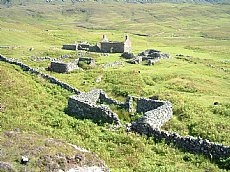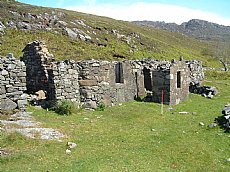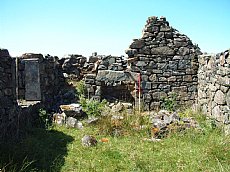Glendrian, Ardnamurchan Post-medieval Settlement
01 July 2019
- News Type:
- Site of the Month

courtesy Highland HER
Glendrian is a depopulated settlement of post-medieval date. It is located on the Ardnamurchan Peninsular on the West Coast of Scotland, situated within a ring of hills forming the caldera of the former volcanic crater of Ben Hiant. The exceptional preservation of the settlement remains, including cruck-slots within house walls, led to the scheduling of the settlement, which is considered to be of regional and national importance.

courtesy Highland HER
Settlement at Glendrian was first documented in the early 17th century, in 1618, when 8 families were recorded living there. From 1723, the population grew, jumping from 29 people to 39 in 1841 and 47 in 1861. The census records show a decrease in the population after this however, and it was during the mid-19th century that the smaller townships on the Ardnamurchan peninsular, including Glendrian, were cleared for larger sheep farms. The population fell to 20 in 1881 and 11 in 1901. By the 1930s, only two houses were occupied, and by the 1940s, the settlement was completely deserted.

courtesy Highland HER
Glendrian does not appear on Roy’s Military Maps of 1747-55, but it does appear on Bald’s map of 1806, on which it comprised 17 buildings, two enclosures, fields and walls. By the time of the 1st Edition OS 6 Inch map of 1876, three unroofed buildings, 17 roofed buildings, 6 enclosures and field systems were present. More buildings were depicted as unroofed on the 1896 2nd Edition OS 6 inch map, with only 8 roofed. A walkover survey was undertaken in 2011 in advance of a bracken control programme and this revealed many more features than mapped however, including previously unrecorded shielings, enclosures and boundaries. A total of 43 individual features were identified; more than half of these related to use of the landscape and transhumance including areas of rig and furrow cultivation and boundary walls, but the rest were structures and features associated directly with the post-medieval settlement, including houses, a revetted spring, a sheep fank and numerous enclosures.
Although a walkover survey does not record sufficient detail for a full assessment and discussion of sites, at Glendrian, it did discover clear evidence of modification and development through time to the settlement. Houses were of varied style and contained evidence for different phases. For example, some buildings had clearly had extensions and additional rooms attached to the pre-existing structures, and the construction of fireplaces within some of the houses were likely related to the latest phase of use. Additionally, the boundary walls and enclosures were all of drystone construction, but these construction techniques varied and these structures also exhibited characteristics of modification.
The level of preservation at Glendrian is considered to be exceptional, especially when compared to similar types of settlements in the Highlands, as most do not usually preserve evidence of modification and phasing through time. In light of this, the site represents a valuable resource into understanding the changes that took place in post-medieval settlement and economy in the Highlands during the 18th and 19th centuries, and a closer study of the architecture of Glendrian would allow for an interesting study into vernacular Highland settlements.
For further information including photos and the data structure report produced by the 2011 walkover survey by West Coast Archaeology Services, see the Highland HER event record: https://her.highland.gov.uk/Event/EHG3782
Further information
http://her.highland.gov.uk/SingleResult.aspx?uid=MHG17470
http://portal.historicenvironment.scot/designation/SM7867
https://canmore.org.uk/site/86744
http://heritageardnamurchan.co.uk/glendrian/
Birch, S and Peteranna, M. 2011. Bracken Control Programme Archaeological Desk-based Assessment and Walkover survey: Ardnamurchan Estates - Glen Drian, Ardnamurchan. West Coast Archaeological Services.
Submitted by Grace Woolmer
Site of the Month Archive
- 10/04/2021 Easter Raitts township
- 02/03/2021 Lower Slackbuie, Inverness (ASDA) Neolithic site
- 01/02/2021 Balnuaran of Clava cairns
- 04/01/2021 Wilkhouse Inn
- 02/12/2020 Spinningdale Cotton Mill
- 02/11/2020 Skibo A Canadian Forestry Camp
- 01/10/2020 WWI Detonator Store, Dalmore near Invergordon
- 03/09/2020 Mesolithic Shell Midden at Sand, Wester Ross
- 08/08/2020 Kinbeachie Neolithic settlement
- 01/07/2020 Armadale Cist Burial and Stone & Timber Complex
